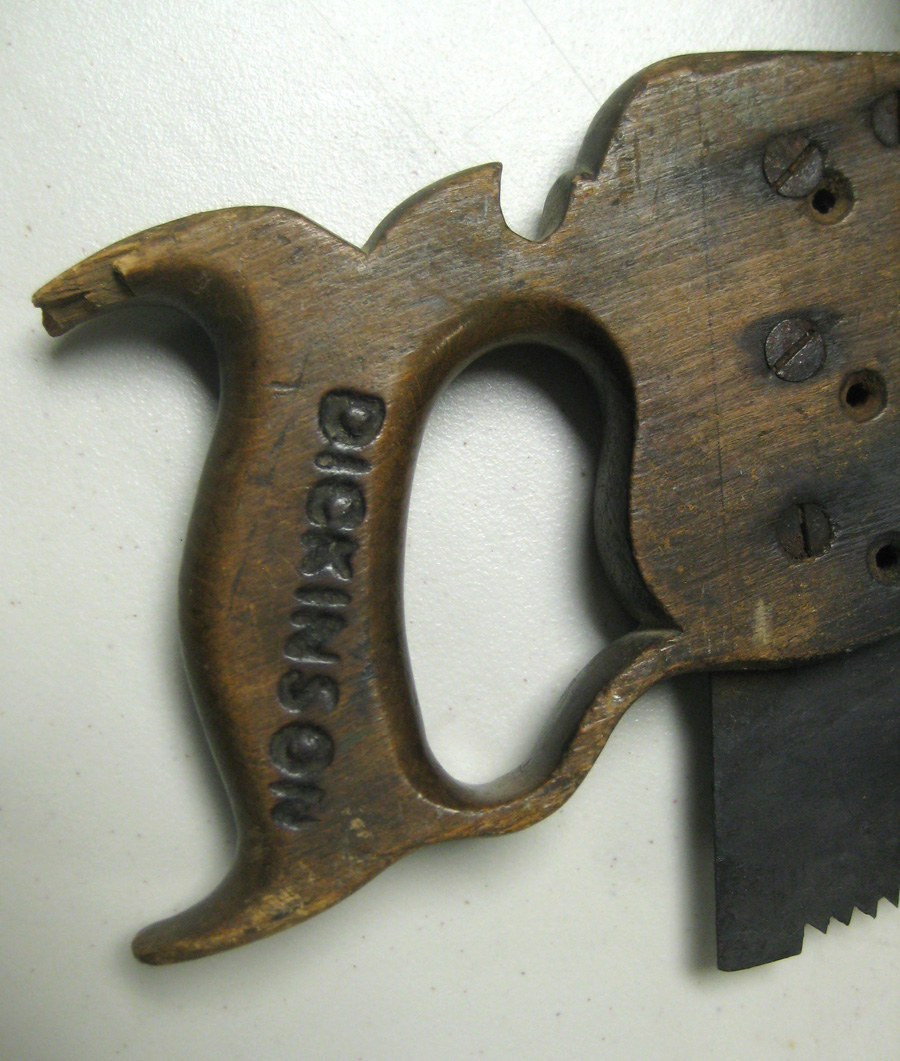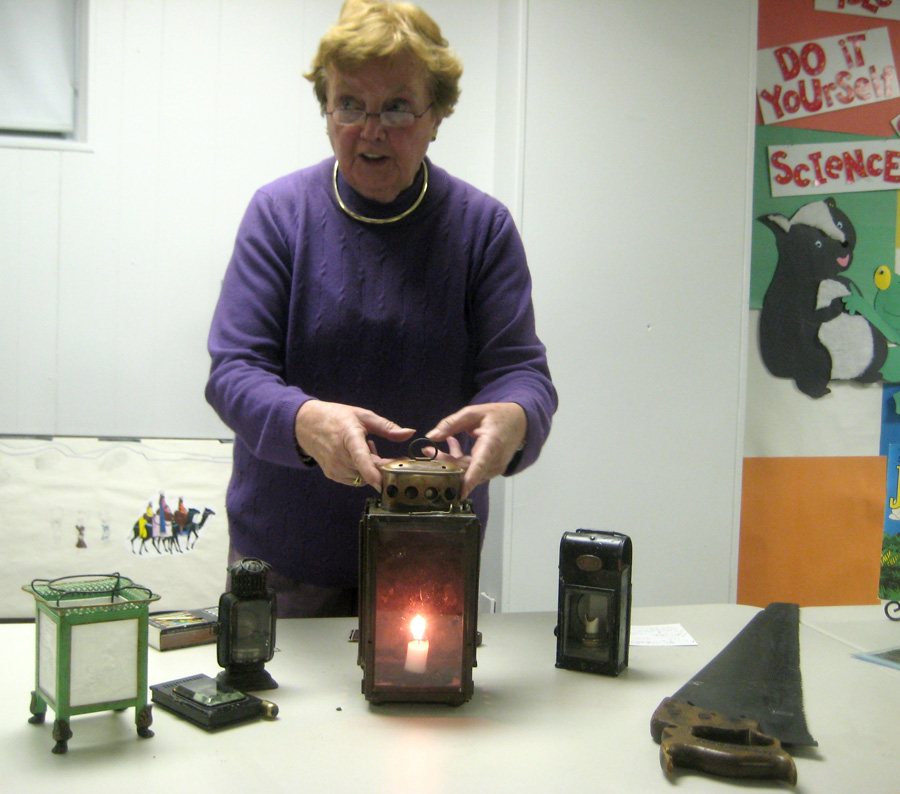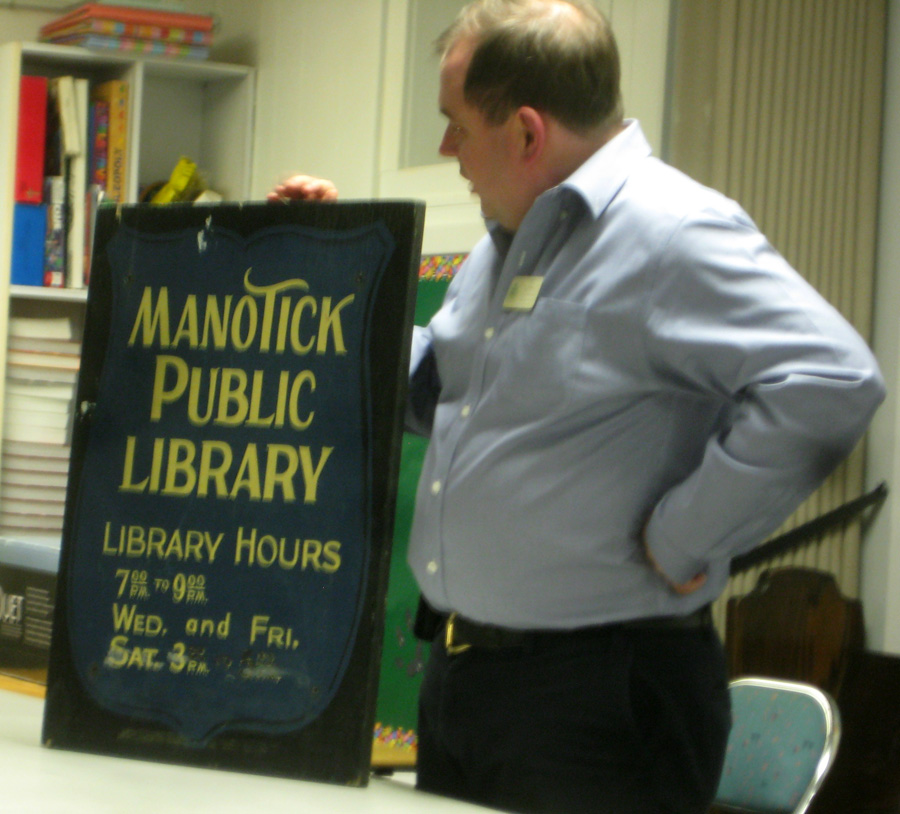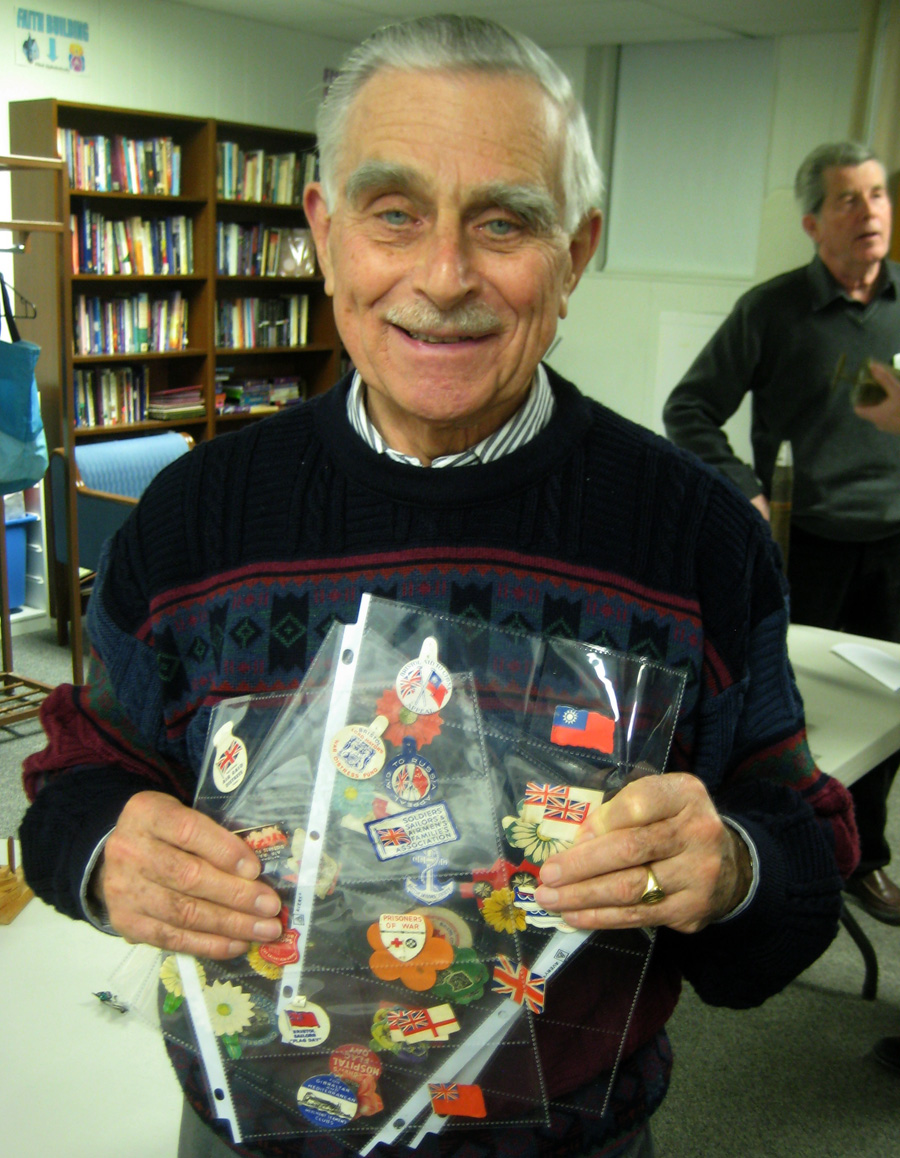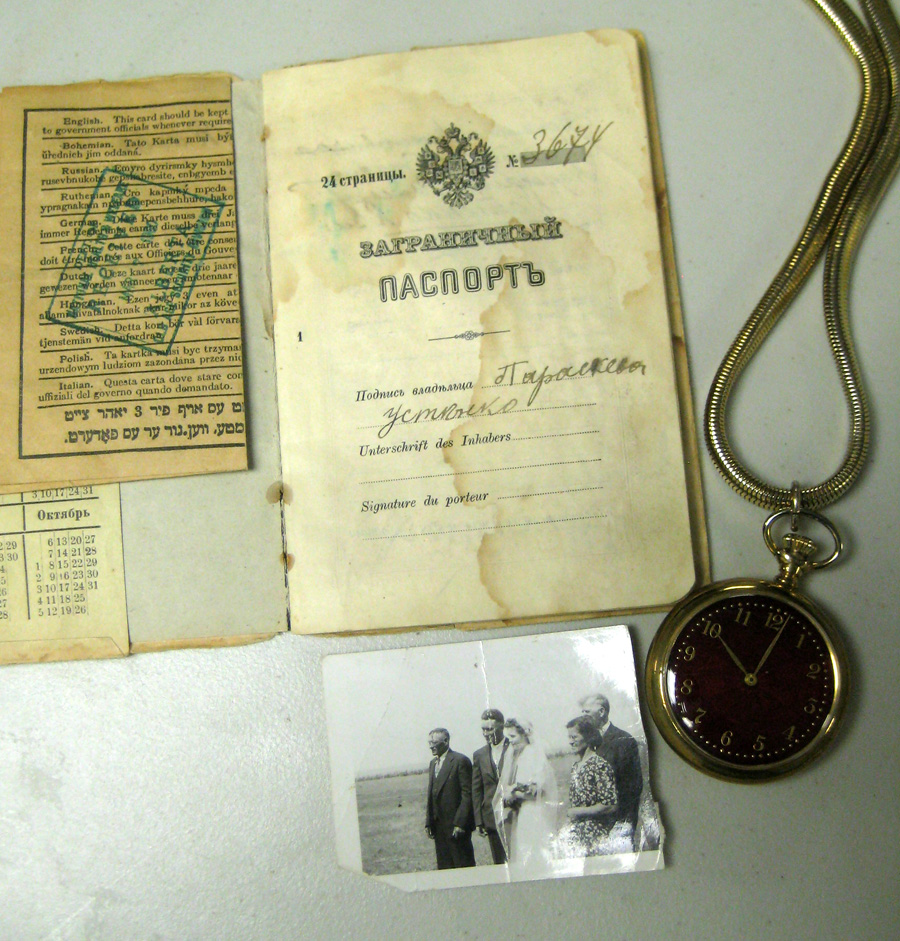The RTHS Annual Bring & Brag for 2012
Presentations by Our Own RTHS Members. Article by Lucy Martin. January, 2012.
The ever-popular “Bring and Brag” meeting drew an interested crowd to the cosy basement of Knox Presbyterian Church in Manotick, which was also the Society's Annual General Meeting. By my count there were 28 in attendance, nineteen of whom stepped forward to present the story behind a treasure, trinket or topic. Here is a summary of those presentations, with apologies for unintentional errors or omissions.
Ron Wilson shared slides from fifteen original documents tracing different ownership of his family's farm, south of Manotick village. One hundred acres of river-side farmland, measured in chains, was purchased for 220 pounds from Heman Hurlburt by John Obrien in 1853. (Both men were styled “yeoman” meaning free man who owns a farm.) Wilson said he liked the elaborate legal language and noted that both husband and wife typically signed the documents. Lindsay A. Wilson, half-brother to Ron's grandfather, brought the property to the Wilson line in 1906. Officiating signatures on the document transferring ownership include William Barnabas Dickinson and George L. Dickinson. Ron says when he volunteers at Dickinson house, he's mindful of these over-lapping connections.
Owen Cooke adhered to his tradition of bringing one of the smallest things, this time it was a wine label from a modern bottle of Vedicchio dei Castelli di Jesi. It features a map of the Italian town of Jesi. Owen shared photos of the walled medieval town, famed as the birthplace of Holy Roman Emperor Frederick II (1194–1250). Jesi is also known for an association with artist Lorenzo Lotto,1480–1556. (Wikipedia says: while active during the High Renaissance, Lotto's work also demonstrates a transitional stage to the Mannerists of the 16th century.) Perhaps most importantly, from the perspective of our audience, a theater in Jesi was where Sir Oliver Leese, commander of the Eighth Army, assembled all officers over the rank of major to explain how he planned to break the German Gothic Line in World War II. (This was the topic of Cooke's co-lecture before RTHS in November of 2011.)
Brian Earl spoke about “trench art”: decorative endeavours done behind the lines to kill time, or done any old time, employing military-type items. Earl's own trench art items consisted of a doorstop, made from a shell casing from a 13 pound artillery piece, decorated with a few German bullets, and an artillery cap badge (metal insignia). The second item was a 40mm Bofors shell (an anti-aircraft auto-cannon) drilled out and ready to be made into a table lamp. Earl says he must have fired off 50,000 such rounds in his two years with a four gun battery. (Some of which was surplus ammo from the 1950's that just needed using up.)
Melanie Hayes brought in a handsome, well-preserved saw with the name “Dickinson” deeply embossed into the wooden handle. It belonged to her father Elijah Scharf who probably purchased the saw at an auction held by Bessie Dickinson in 1930. It came down to Bessie through her father, Moss Kent Dickinson, the founder of Manotick. (Embossing like that looks like an excellent way to be sure a borrowed tool will be returned, or at least remembered!)
Colin Wright detailed portions of his family line, beginning with his great-great-great-grandfather, Philemon Wright (1760-1839) a farmer, entrepreneur and lumberman who founded Hull, the first permanent settlement in the National Capital Region. Philemon hailed from Massachusetts before coming to Canada as a United Empire Loyalist. Colin shared a book from another Philemon descendent called the “White Chief of Ottawa” by Bertha Wright Carr-Harris. Of the many Wrights found throughout the region, Colin comes from the Christopher Columbus Wright line of descent. His grandfather lived in Old Chelsea, before moving to the Kemptville area. Colin shared a photo of a steam engine his grandfather used to heat the sand and bricks to build the Kars elementary school which was recently torn down. Colin's father Harry founded H.O. Wright and Sons, an electrical, plumbing and heating company still going strong in North Gower.
Pat Earl spoke of how formal courtship rituals now seem like quaint relics of days gone by. She held up a sweet little glass “courting lamp”, a gift from her son Jeff. Asked for her best guess, lamp expert Val Lister estimated it probably dated from the 1880's. Earl says she's never checked how long her wee lamp would burn. A Google search on courtship lamps produced this comment from a gallery in Ohio: “Depending on how much oil Daddy put in the lamp was how long your guy could stay out on the porch and visit. Sometimes Dad only put a couple of drops in.”
Allan Haan brought a pitcher/vase that looked to be copper with blue decorative bands. It came via his grandmother, who said it had been in the family a long time. Haan doesn't actually know much about it and it has no visible manufacturer's marks. Haan was hopeful someone in the audience might know more about understanding its age and such.
Tom MacDonald shared a chronicle of Carlsbad Springs (near Navan). His great-grandfather came to the area about 1840. The chronicle goes through 1919. MacDonald called it a good read and a useful resource for anyone with ancestors from that area.
Yours truly (Lucy Martin) brought two family items that celebrate creative problem solving. The first was a small wooden puzzle (sometimes called“the towers of Hanoi”) made by her paternal grandfather, Joseph Martin. The second was a recent gift of a silver and gemstone pin – a cat figurine – made by her Aunt Gail Martin, a retired art teacher. The pin earned Aunt Gail an “A” for a final exam at her Mills College jewelry making class. The assignment was to combine a gemstone and metal mounting without using the fastening techniques covered in class. Aunt Gail said the exam produced much student complaint, but it was intended to simulate real-life. The ability to solve problems creatively (using limited resources, while under pressure) is an art worth mastering.
Ruth Wright shared several small items that belong to her in-laws: a little purse used by her father-in-law to hold tickets for Ottawa street cars. A second item was a small Red Cross pin awarded to her mother-in-law for knitting socks for soldiers serving in WW II. She knitted about a pair a day while the family lived in Renfrew and her husband worked at something called “the hush factory”, which made special glass for submarine periscopes.
Dennis Osmond brought in items first collected in his childhood in the early 1940's in Bristol, England, where he later trained as a medical doctor. The first was a medicinal tin that originally contained iodized throat tablets and sold for 9.5 pence, including tax. Once empty, the tin was where he stored his collection of 35 emblems, small fund-raising decorations showing support for a cause and reflecting a charitable donation – the same idea as today's poppy pin, but made of paper, not plastic. From National Air Raid Distress Fund, Bristol Lord Mayor's War Distress Fund, Huts for Troops, and so on, Osmond found it extraordinary that people who were experiencing hardships (including intensive bombing in their own city) would still scrape up extra change to help others. For his part, Osmond and a friend put together a traveling puppet show to raise funds for Russian war allies, for which they received a very nice thank-you letter personally signed by Clementine Churchill. Post-war causes included support for local hospitals, waifs, strays and orphans and child protection – services more often covered now by government programs.
Coral Lindsay presented material and artifacts that detailed the remarkable life of Jumbo the elephant and his connection to St. Thomas, Ontario. Jumbo was captured in the wilds of Africa as a young elephant and transported to a zoo in Paris in 1861. He was poorly cared for and was eventually traded for a rhino from England in 1865. In England his health, demeanor and growth improved under the attentive care of Matthew Scott. Jumbo grew to notable size (approximately 12 feet in height, 14 feet in length, and weighing seven tonnes. Seventeen years of ever-greater fame in England made the elephant attractive to American showman extraordinaire, P.T. Barnum. To the great dismay of British children and animal lovers, Jumbo was sold for ten thousand dollars. If there was one silver lining to the sale it was that Jumbo and his devoted trainer Scott did stay together. Jumbo enjoyed acclaim and success with the “greatest show on earth” from 1882 to his tragic death in St. Thomas, Ontario in September of 1885, when he was struck by a train. A privately-funded, life-sized concrete statue of Jumbo was erected in St. Thomas in 1985, the centennial of his death.
Val Lister has to take the weather into account when bringing items from her extensive lamp collection. It was too cold to bring lamps, so she brought different types of lanterns instead. Lantern number one was made in Birmingham, England in 1913, by Rose and Burley, with a (rare) porcelain burner. Number two was from Nuremberg, Germany with a chimney that slides up, a fitted bale handle, and it threw a nice light, when lit. Lantern number three was described by Lister as being older and not in very good condition, but is still special as a whale oil lamp, probably made in the U.S. Lantern number four was about the size of a stack of cards with a spring-lifted “dripless” candle and was also charming when lit, just right to go to bed or to guide a night-time “comfort run”. The pièce de résistance was a green, four-sided candle-burning box, known as a lithopane, circa 1880-1900. Each wall is a thin porcelain “slide” with a carved image, in this case depicting scenes of home life. (see photo). Delightful!
Linda Reasbeck brought two items that remind her of her grandparents' profound courage as they chose to leave pre-revolution Russia in hopes of building better lives in Canada. Like many immigrants of the time, Reasbeck's grandparents were intent on learning English and integrating into their new homeland. As a result, much family history was left behind or suppressed in favor of becoming Canadian. Reasbeck treasures her grandfather's striking red pocket watch, which still runs. After arriving in Saskatchewan in 1909 and working three years as a laborer, he saved enough to bring over his two sisters, a brother-in-law and a niece. Meanwhile, Linda's grandmother worked as a maid before saving enough to come to Canada on her own as a steerage passenger in 1913, seasick the whole voyage. That grandmother joined distant relatives in Saskatchewan, before marrying in 1914. Linda shared her grandmother's Russian passport and a photo of her Russian grandparent's at her parent's wedding, as well as a photo of their tombstones.
Gerry Reasbeck brought his father's cowboy chaps (the very furry kind!) made of goat hide, dating from the 1920's. Reasbeck's father Fred grew up near Vankleek Hill, Ontario. At 19 Fred's adventurous spirit took him out west, where he worked and eventually owned his own cattle farm 30 miles east of Calgary. Gerry imagines his father's warm chaps would have been just the thing to ride ten miles across a frigid prairie to attend Masonic Lodge meetings, then turn around and ride those even-colder ten miles home again, as was his habit. Fred Reasbeck lived a healthy, industrious and successful life before passing on just shy of age 102. He was, in his son's words, “A great guy.”
Mark Jodoin began by explaining that his eldest brother Stephen greatly admires Samuel de Champlain (1567?-1635). A few years ago, Stephen presented Mark with a Christmas present, a book described as a definitive masterpiece on Quebec's founding explorer: “Champlain's Dream” by American historian David Hackett Fisher. It was published in 2008, amid 400th anniversary hoopla of Champlain's arrival in North America. The biography depicts Champlain as a brave and far-sighted leader in a violent era who nonetheless championed humanity and peace. Jodoin also shared a June 21, 1908 colour page illustration from the sometimes-notorious Le Petit Parisien newspaper (published between 1876-1944) commemorating Champlain's 300th anniversary, an item he bought as a reciprocal Christmas gift for his brother.
Jane Anderson brought her maternal grandmother's autograph album from 1886. Jane Fulton lived in New Glasgow, Quebec and family lore holds that future Prime Minister Wilfrid Laurier came to stay with them to improve his English. In reading the entries, Anderson was struck by the average young women's preoccupation with matrimony, in an era that offered few alternative paths for the female gender. A sample entry: “Jane Fulton is your name, single is your station. Happy be that little man who makes the alteration.”
Marguerite Rogers has a long-standing interest in pre-historic peoples of North America. She shared material related to the mystery of the Kennewick man, human remains accidentally discovered on the banks of the Columbia River in 1996, thought to date from 9300 years ago. (Marguerite and her husband Stuart toured a volunteer-run museum on this subject in Kennewick, Washington this past September.) The puzzling discovery became exciting – and then controversial – due to uncertainty about the geographic origin of this person. Natives in the area claim the skeleton as an ancestor, and want it treated as such. Some scientists feel it may represent a human from somewhere in the orient, perhaps an island near Japan? Rogers says the issue has become a cultural, scientific and political football, mired in legal disputes that await further resolution.
Manotick Library employee Greg Hutton is a familiar face to area book lovers. Hutton brought in a Manotick Library sign that can be dated to at least 1973, back when the library was housed in the Ayers Building. The sign just mysteriously showed up, propped outside the present Manotick Library in the summer of 2009. Where had it been? Who painted it? Who brought it back? In spite of not knowing those details, Hutton was pleased to recover a relic of the library's recent history as well as a fine sample of calligraphy, a now-scarce hand-painted sign. The sign shows that area patrons once had to be satisfied with a mere 6 hours of library access per week, as compared to the 54 hours available today. The Manotick Library will mark its 125th year in 2015.
As usual, the items were interesting in and of themselves. The stories, memories and insights contributed by each presenter added rich frosting to each 'cake'. Thanks again to all who shared. And, dear reader, what might you bring to the next 'bring and brag'?
